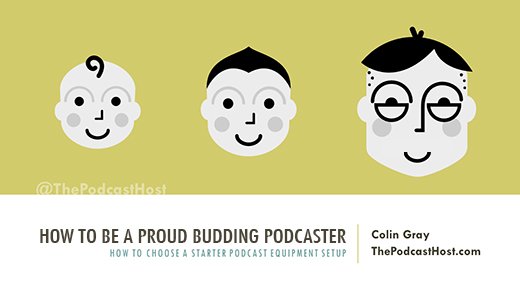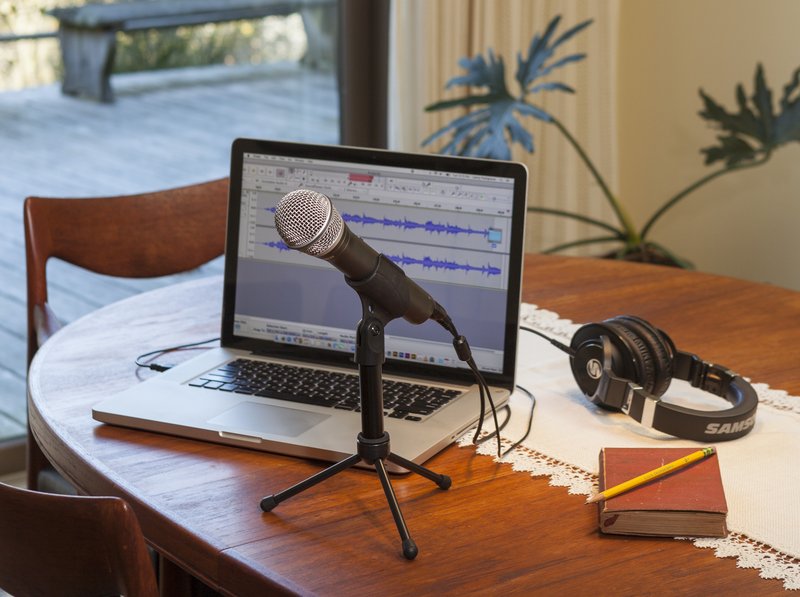How to be a Proud Budding Podcaster: Starter Equipment Setups

Let’s start with the basics: It’s not a race!
This is one of the most common pitfalls for budding podcasters when first starting out. In thinking so, many budding podcasters ruin (or hugely delay) their chances of creating a great show.
It starts by comparing yourself to others. By moving too fast as a result. By missing some of the really valuable steps in a podcaster’s journey.
There’s a wide range of areas this applies to, from format to promotion. But the biggest speed trap, for many, is equipment.
In this article, I’m going to tell you why you should be proud to be a budding podcaster. Why you should relish the phase, and why you should avoid rushing ahead.
I’m hoping this will help you get started in the right way, with the right type of setup. And I’m hoping that it’ll help you avoid The Race, gaining the self-confidence to podcast in a way that suits you.
Trust me, if you do that, you’ll greatly reap the benefits long term.
The Race? What Race?
The Equipment Arms Race, that’s what. I’ve fallen into the trap, and I know millions have before me.
You make a plan for your show, and then you ask: how do I record this? So, you search for podcast equipment online. Of course, it’s the people that have been broadcasting for years that you find first.
That means they’re showing off a set of $400 condenser mics plugged into a 12 channel mixer, communicating via mix-minus into a dedicated Mac Mini, recording to a stand-alone recorder and drawing FX from a Soundbyte equipped iPad.
Or something equally complicated…
And you join The Race. The Race to jump well ahead of your stage. The race to keep up with the pros. The race you think you need to be in to produce good quality audio and a successful show. That means buying expensive equipment, and lots of it. It means buying mics, mixers, recorders, stands and a whole host of other things. It means creating a setup that’s great quality, yes, but also really complex.
I can tell you that few of those pro broadcasters started out that way. Most, in fact, probably lived in the budding podcaster phase for far longer than you think. They became pro because that phase taught them the skills and gave them the experience to be good at what they do. Pro audio quality is the icing on the cake, it’s the experience beneath that that makes for a successful show.
The Budding Podcaster
I would argue that there’s one thing, and one thing only, that matters to a brand new podcaster.
Consistency.
Obvious, yes, but running The Race, jumping into complex audio setups, ruins it. It creates a huge range of barriers, all of which hamper consistency. The three big ones are:
- Greater complexity means more time not creating: there is a larger learning curve
- Greater complexity means more time not working: it takes longer to set up each time.
- Greater complexity means greater fragility: it’s more likely to break!
When you’re new, you’re doing this entirely for free, and with only a hope and a prayer that it’ll pay off in the long run. That means time is really precious. So, you can’t afford the time to spend setting up your equipment each time. You also can’t afford the time to work out what is broken or what settings have changed since you last used it.
The more time you spend on setup and troubleshooting, the less time you spend on recording! And that hampers consistency. On the other hand, if you stick to a really simple setup, here are the advantages:
- Record, at a moment’s notice, any time.
- Concentrate fully on the content, not the equipment settings
- Spend maximum time on improving your speaking craft
- Devote maximum focus to improving your content design craft.
The first two are the key to consistency. Create a low-barrier way of recording and you’ll do it more often.
This then leads to the latter two. The more consistent you are, the more practice you’re getting. And the more practice you’re getting, the better you get.
That’s what makes for a successful show: becoming great at designing and delivering great content.
Where Next?
Of course, every budding podcaster blooms. And that’s when you can start to think about upgrading your setup.
For me, here’s when the upgrade is justified:
- You have a core group of loyal listeners, proving demand for your show
- You’ve become a practiced, confident presenter
- You’re creating consistently useful and engaging content
Once you’ve hit this trifecta, then it’s worth investing in upgrading your recording equipment. Before you hit this stage, though, you’ll get far more bang for your buck in improving any of the three.
Of course, this comes with one caveat – you do need a minimum level of audio quality. No-one’s going to listen to your 30 minute show recorded on the internal mic of a $300 laptop where your listener hears more ambient noise than the sound of your voice.
So, let’s look at that next, where do we start?
Budding Podcaster Setups
The key at this point is that you want to use simple equipment and a quick workflow. One of the best options is a decent USB mic, recording directly into a computer audio editing package like Audacity.
This process lets you record quickly and easily, do the minimum editing you possibly can, and then export the finished audio file. From there, it’s uploaded directly to your podcast host.

Samson Q2U – Easy & Future-proof
Samson offers a number of microphones that are good value, simple to setup, that give you great quality AND future-proof yourself for the next stage in your podcasting lifecycle.
If you look at my article on ThePodcastHost.com titled Best Podcasting Microphones, you’ll see that we recommend the Samson Q2U as a great introductory mic for this very purpose.
The Q2U package is excellent as it contains everything you need to get started: not only the mic itself, but a small stand and pop filter. On top of that, the Q2U offers that future-proofing I mentioned through a dual output – it also works with XLR cables. This means that once you’re ready to expand your show, the Q2U can integrate with digital recorder or mixer setups. You’ll never have to throw it away!
For some, though, you know you’re never going to be into the tech. The idea of mixers or digital recorders is about as alien to you as the surface of mars.
In that case, I often recommend people just invest in a higher-level USB mic right from the start. Samson offers a great option here too in the form of the Meteor Mic.
The Meteor Mic comes with an inbuilt stand and is completely plug and play. No fuss, no setup – just record! As budding podcasters, that’s exactly what you need.
For remote interviews, the Samson Go Mic is a great solution to integrate into your portable setup. It’s a miniature USB studio microphone that fits in the palm of your hand. It has a built-in clip that attaches to your laptop monitor, as well as two pickup patterns for different recording situations: unidirectional for a one person show and omnidirectional when conducting an interview.
The Main Reason to Enjoy Your Budding Phase
My hope here was to encourage you to start off small. Think simple with your setup, and concentrate on becoming the best presenter you possibly can be.But I haven’t even mentioned the best bit. When you’re a budding podcaster, you can get away with almost anything, and you’re encouraged to experiment! This is why there’s little benefit in spending a fortune on audio equipment or a soundproofed room.
As a budding podcaster, along side the practice, you should be trying everything. You’ll have few listeners at this stage anyway, so experiment with format, location, style, anything! Before you tie yourself into a pro audio setup, figure out how and where you’ll be recording first. And that’ll be based chiefly on what your audience wants to hear.
Remember, in the early days, just put yourself out there however and whenever you can. It’s only by doing that that you’ll find your style and your audience. After all, if we can’t learn and experiment as budding podcasters, then when can we? Enjoy!